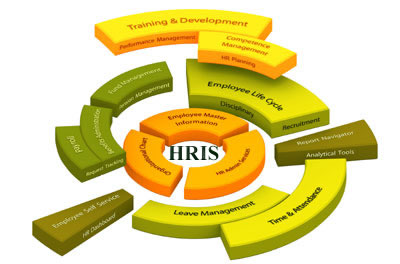HRIS refers to Human Resource Information System or Human Resource Management System (HRMS). This is basically an intersection of human resource with information technology by using HR software. This process helps to do many activities, including human resource, accounting, management, and payroll. The HRIS system helps in doing the same work more cost effectively without hiring any extra resource. This also leads to an increase in the overall efficiency of a company.
Solutions offered by adopting the HRIS system are as follows:
- Payroll
- Time and attendance
- Performance appraisal
- Benefits administration
- HR management
- Recruiting/Learning management
- Performance record keeping
- Employee self-service
- Scheduling
- Absence management
- Analytics
The payroll module helps to run the pay process by gathering data on employee time and attendance, calculating various deductions and taxes, and generating periodic paychecks and employee tax reports.
The time and attendance module helps in gathering standardized time and work related efforts.
The benefits administration module helps the organizations to administer and track employee benefits.
The HR management module comprises many other HR aspects from application to retirement. Online recruiting has become one of the primary methods used by the HR department to select the right person for the job. This system is called as the talent management system. The system emphasizes on:
- analyzing personnel usage within an organization
- identifying potential applicants
- recruiting through company-facing listings
- recruiting through online recruiting sites or publications that market to both recruiters and applicants
The performance record keeping / training module helps an organization to administer and track employee training and development efforts. The system is usually known as the “learning management system” (LMS).
The employee self-service module helps the employees to query HR related data and perform some HR transactions over the system.
The Analytics module makes it possible for organizations to extend the value of an HRMS implementation by extracting HR related data for use with other business intelligence platforms.
The types of Human Resources Management System (HRMS) or Human Resources Information System (HRIS) are now of various versions:
- Some of which are typically local-machine based software packages
- The other main type is an online cloud-based system which can be accessed via a web browser.
Today, most companies depend on cloud based systems, making it possible for corporate HR managers to stop the frustrating cycle of upgrading systems every year or two. The Cloud technology makes it easier to switch and replace their vendors.
The five main components of HRIS are as follows:-
- Database Management
- Time and Labor Management
- Payroll
- Benefits
- Employee Interface
According to the HRIS Analyst of Northern Michigan, HRIS will be responsible for providing data and form audit reports and analysis, proposal support both written content and data, research into report or data outputs, provide back-up and assistance as needed, with their domestic relocation program.
